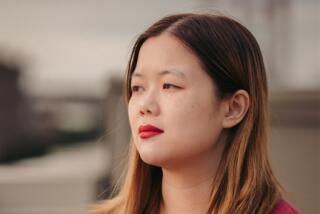Review: Mary Gaitskill takes on race, class and motherhood in her new novel ‘The Mare’
Imagine the cast of Mary Gaitskill’s last novel, “Veronica,” denizens of the downtown art galleries and clubs, if they got sober, got jobs and moved to upstate New York to raise families. This is the world of Ginger, a 47-year-old failed artist and recovering alcoholic, and her professor husband, Paul, in “The Mare.”
Now imagine a disadvantaged Dominican girl and a middle-age white woman drawn to each other by profound need, and the horse that will change their lives. A Fifty Shades of Racism and White Privilege that will make readers, particularly white readers, uncomfortable in ways that depictions of sadomasochistic sex can’t.
------------
For the record: An earlier version of this article said that the character Velvet in ‘National Velvet’ was a horse. She was the horse’s rider.
------------
Since the death of her sister (once an avid rider), Ginger has been troubled. The loss of her sister, her inability to make art, her reluctance to go back to drugs, alcohol or her abusive former lover have created an emptiness she believes can be filled by adopting a child. Resistant at first, Paul agrees to a compromise. They will take in an inner-city child for a few weeks to test the waters of adoption. Among the busload of disadvantaged kids from New York City being brought to the bucolic countryside to stay with eager upper middle-class families is Velvet Vargas, a bright, sensitive 11-year-old Dominican girl, starved for the love she hasn’t been getting from her beleaguered and abusive single mother, who favors her lighter-skinned brother.
The range of Gaitskill’s humanity is astonishing and matched only, it seems, by a desire to confront readers with the trembling reality of our shared ugliness. Is it possible that Gaitskill can still shock us?
She chooses to use alternating first-person chapters, from the points of view of Ginger and Velvet, with an occasional chapter given over to Paul or Mrs. Vargas, Velvet’s mother. The juxtaposition of these women’s lives — poor brown girl and rich white woman, mother and daughter, mother and nonmother — is dramatic. It’s an education to see how different life looks filtered through the lens of privilege, race and age.
There is irony in Velvet’s name, since there’s nothing soft about Velvet’s life. Even more so because Velvet is the name of shy but determined horse-crazy heroine in the classic book and movie “National Velvet.” Through Velvet’s eyes, Ginger and Paul’s world is something out of a strange fairy tale. She responds with pleasure to the things they offer: a bicycle, her own room, new clothes. But she also loves the way Ginger brushes her hair and reads to her at night, the way she tells Velvet she’s beautiful and takes longs walks with her.
Even so, nothing compares to the feeling Velvet gets when she enters the stables across the street. It’s here that she meets the eponymous mare, a rescue horse so tormented and charged with rage that she is unrideable. The snotty white kids at the barn have named her Fugly Girl. Velvet rechristens her Fiery Girl. From the moment Velvet meets her horse, she says, “I felt our minds pressed together, each feeling where the other was.” That Velvet’s mother has strictly forbidden her to even get on a horse is immediately forgotten.
Velvet may be consumed with her mare, but it’s clear to Paul that Ginger is consumed with Velvet, swimming away from the shore of reason. “There’s a limit to what you can be to each other,” he warns, but Ginger has fantasies of the future, of spending birthdays together. Later that night, turned away from her sleeping husband, Ginger muses, “I thought of the way she said, ‘My mare,’ like ‘mah mare’ or ‘ma mere’ — my mother in French.”
Ginger may believe that brushing Velvet’s hair and taking her to the stables makes her a mother, but Paul’s ex-wife and her gang of local mean mommies are quick to call out Ginger’s interest in Velvet as reckless, little more than a hobby. Velvet’s mother sees danger of a different kind. Having been bitterly disappointed by her own fate, she believes Ginger offers her daughter only the illusion of choices and the promise of failure and heartbreak. It seems better for the mother to break her daughter herself.
Gaitskill has always been attracted to the “great ferocity latent in women” and is an expert at anatomizing the cruelties women inflict on one another. Here, it’s the rarely acknowledged hostilities that sometimes surface among women who choose to become mothers and those who choose not to. Velvet’s mother is suspicious of Ginger from the start because she doesn’t have children of her own. In every culture, there is something considered unnatural, even frightening, about a woman who doesn’t choose to become a mother or who is physically unable to become a mother.
Regardless of species, females are powerful creatures. As a trainer explains to Velvet: “The thing about mares? They will always draw a line in the sand. Stallions, geldings, they can be tough. But ... eventually she will draw a line in the sand, and when she does that — cross it and she is going to take you down, even if she has to die doing it. Just like a woman. It’s why some people don’t like mares.”
This is a coming-of-age story in the way we are always coming of age, whether we are 13 or 47. What elevates it is the way Gaitskill rides herd on sentimentality, which isn’t to suggest that the work isn’t emotional — it is. It’s just that there are no false notes, no stumbles in the rare moments of tenderness. It’s brave and bold to publish a book like this. Make no mistake: The women in this book, like Gaitskill herself, are mares.
Schappell is author of the novel “Blueprints for Building Better Girls.”
::
The Mare
A Novel
Mary Gaitskill
Pantheon: 441 pp., $26.95
More to Read
The biggest entertainment stories
Get our big stories about Hollywood, film, television, music, arts, culture and more right in your inbox as soon as they publish.
You may occasionally receive promotional content from the Los Angeles Times.









